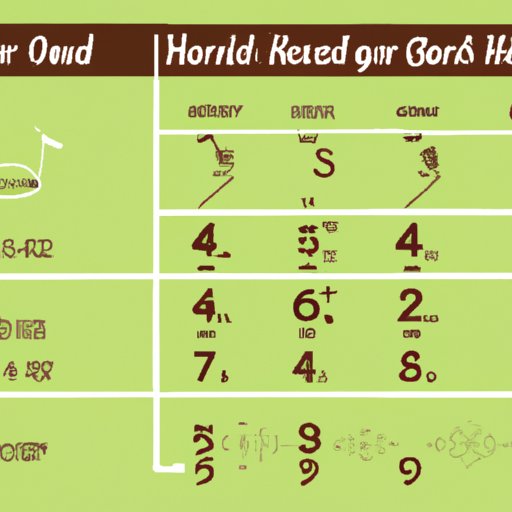Introduction
Golf is a game of skill, strategy, and precision. It requires knowledge of the rules and etiquette, as well as an understanding of how to calculate a golf handicap. Knowing how to calculate a golf handicap is key to improving your overall score and performance on the course.
A golf handicap is a numerical measure of a golfer’s potential ability. It is used to determine a golfer’s playing ability and is determined by taking into account their past performance across different courses. It is calculated using a combination of the player’s scores, the slope rating of the course, and the course rating.
Exploring the Basics of Handicap Calculations in Golf
Handicaps come in two different forms: a USGA Handicap Index and a course handicap. A USGA Handicap Index is an average of the best 10 out of 20 rounds of a golfer’s last scores. It is based on the golfer’s average score over a number of rounds and is adjusted for the difficulty of the course. On the other hand, a course handicap is the number of strokes that are taken off of a golfer’s score when playing a specific course.
The Slope System and Course Rating are two important elements when calculating a golf handicap. The Slope System is a numerical rating system that measures the relative difficulty of a golf course for a bogey golfer (a golfer who shoots one over par). The Course Rating is the estimated score that a scratch golfer (a golfer with a 0 handicap) would shoot on a given course.
In order to establish an initial handicap, a golfer will need to submit at least 5 scores to a golf club or handicap service. These scores must be from 18-hole rounds played on courses with a USGA Course Rating. Once these scores have been submitted, the golfer will receive a Handicap Index, which can then be used to calculate a course handicap.

A Comprehensive Guide to Understanding How Golf Handicaps are Calculated
Calculating your Handicap Index is relatively straightforward. First, you must select the appropriate score for calculation. This should be the lowest score out of your last 20 rounds that is within the last 12 months. Then, you must subtract the Course Rating from the player’s score. This gives you the Adjusted Gross Score (AGS). Finally, you must adjust the Handicap Index with the Slope Rating.
There are several factors that can affect a golfer’s Handicap Index. These include the golfer’s age, gender, and skill level. Additionally, the type of course played and the weather conditions during the round can also influence the calculation. For example, if a golfer plays a more difficult course, their Handicap Index could be higher than if they had played an easier course.
The Breakdown: A Step-by-Step Look at Calculating Golf Handicaps
When calculating golf handicaps, it is important to select the appropriate score for calculation. This should be the lowest score out of your last 20 rounds that is within the last 12 months. Once the appropriate score is selected, you must subtract the Course Rating from the player’s score. This gives you the Adjusted Gross Score (AGS).
Next, you must adjust the Handicap Index with the Slope Rating. The Slope Rating is a numerical rating system that measures the relative difficulty of a golf course for a bogey golfer. The Course Rating is the estimated score that a scratch golfer would shoot on a given course. Finally, you must add the AGS and the Slope Rating together to get the final Handicap Index.
An In-Depth Analysis of How Golf Handicaps are Determined
It is important to understand how different scenarios can affect a golfer’s handicap. For example, if a golfer plays a round on a course with a much higher Course Rating than their average, their Handicap Index may increase. Additionally, if a golfer plays a round on a course with a much lower Course Rating than their average, their Handicap Index may decrease.
Another factor to consider is the role of handicap trends. If a golfer’s scores have been steadily increasing over time, their Handicap Index may increase as well. Conversely, if a golfer’s scores have been decreasing over time, their Handicap Index may decrease.

Revealing the Secrets Behind Calculating Golf Handicaps
In order to understand how to calculate a golf handicap, it is important to familiarize yourself with the different terminology used. This includes terms such as the Handicap Index, Slope System, Course Rating, Adjusted Gross Score (AGS), and Slope Rating. Once you understand these terms and how they are used, you can begin to calculate your own golf handicaps.
Having an accurate golf handicap can be beneficial in many ways. For example, it can help you track your progress and compare your performance to other golfers. Additionally, it can help you identify any weaknesses in your game and make adjustments accordingly. Knowing how to calculate a golf handicap can be an invaluable tool for improving your overall performance on the course.
Conclusion
Golf handicaps are an essential part of the game and can provide valuable insight into a golfer’s performance. Knowing how to calculate golf handicaps is key to improving your overall score and performance on the course. This comprehensive guide provides a step-by-step look at how golf handicaps are calculated. With this knowledge, you can start tracking your progress and making adjustments to become a better golfer.


